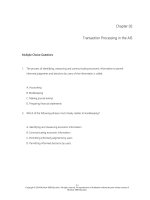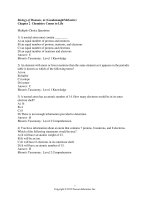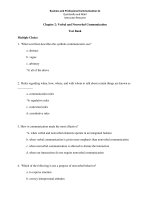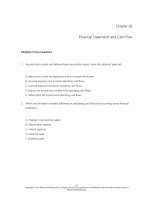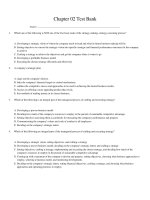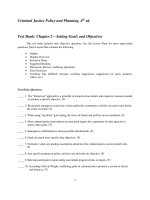Math and dosage calculations for healthcare professionals 4th edition booth test bank
Bạn đang xem bản rút gọn của tài liệu. Xem và tải ngay bản đầy đủ của tài liệu tại đây (220.06 KB, 44 trang )
Chapter 002 Decimals
True / False Questions
1. Places to the left of the decimal point represent fractions.
True False
2. Places to the right of the decimal point represent fractions.
True False
3. A zero should always be placed to the left of the decimal point if there is no whole
number.
True False
4. 0.1006 < 0.01006
True False
5. 0.0122 > 0.0012
True False
6. 4.908 > 4.980
True False
7. 53.256 > 53.254
True False
8. To convert a fraction to a decimal, divide the denominator by the numerator.
True False
2-1
Chapter 002 Decimals
9. To convert a fraction to a decimal, divide the numerator by the denominator.
True False
10. When rounding decimals, if the number to the right of the target place value is 5 or less,
the number in the target place value is not changed.
True False
11. If the number in the target place value is 5 or more, the number can be rounded up one
unit.
True False
12. When converting decimals to fractions, the place value of the number farthest to the right
is the denominator.
True False
13. 1.23 = 123/100
True False
14. 45.60 = 45 6/100
True False
15. 0.350 = 35/100
True False
16. When multiplying decimals, the total number of places in both numbers are counted and
used to place the decimal point in the answer.
True False
2-2
Chapter 002 Decimals
17. When dividing decimals, the decimal point is ignored.
True False
18. A trailing 0 is placed after the decimal when calculating medication dosages to help
prevent medication errors.
True False
19. The more numbers to the right of the decimal point the smaller the value.
True False
20. When comparing decimals start with the whole number and work to the right until one
number is greater than the other.
True False
21. When converting a fraction to decimal, consider the fraction as a multiplication problem.
True False
22. It is not necessary to align the decimal points when adding or subtracting decimals.
True False
23. When adding or subtracting decimals, if the decimals do not have the same number of
places, add zeros to the end so all the numbers have the same number of places.
True False
24. Prior to multiplying decimals, you should move the decimal point to the end of each
decimal.
True False
2-3
Chapter 002 Decimals
25. When dividing decimals, move the decimals to the right the same number of places in
both the divisor and dividend until the divisor is a whole number.
True False
26. 4.53 x 6.4 = 289.92
True False
27. 5.6 x 0.0002 = 0.00112
True False
28. 2.34
0.6 = 3.9
True False
29. 2.456
10 = 24.56
True False
30. 254.5
4.56 = 558.11 (rounded to the nearest hundredth)
True False
Multiple Choice Questions
31. 1000 x 22.7 =
A. 227
B. 2270
C. 22700
D. 227000
2-4
Chapter 002 Decimals
32. 6.5
100 =
A. 0.65
B. 0.065
C. 0.0065
D. 0.00065
33. 950.03
10 =
A. 95.003
B. 9.5003
C. 0.95003
D. 0.095003
34. 800.12 x 1000 =
A. 8.0012
B. 8001.2
C. 80012
D. 800120
35. 0.85 rounded to the nearest tenth is
A. 0.8
B. 0.9
C. 1.0
D. 0.86
36. 4.499 rounded to the nearest hundredth is
A. 4
B. 4.49
C. 4.5
D. 5
2-5
Chapter 002 Decimals
37. 89.3233 rounded to the nearest thousandth is
A. 89.32
B. 89.33
C. 89.323
D. 89.32414
38. 6.35 rounded to the nearest tenth is
A. 6.38
B. 6.39
C. 6.4
D. 6.3
39. 10.6477 rounded to the nearest tenth is
A. 10.6
B. 10.64
C. 10.65
D. 11.0
40. 0.085 + 0.73 =
A. 8.15
B. 0.00815
C. 0.0815
D. 0.815
41. Each position in a decimal number has a __________ value.
A. monetary
B. place
C. fraction
D. whole
2-6
Chapter 002 Decimals
42. A _____________ should be used as a placeholder to the left of the decimal point when
there is no whole number.
A. one
B. five
C. a place holder is not needed
D. zero
43. When comparing the value of decimals, the correct sequence is
A. whole number, hundredths, tenths, thousandths
B. ignore the whole number, compare tenths, hundredths, thousandths
C. whole number, tenths, hundredths, thousandths
D. thousandths, hundredths, tenths, whole number
44. Adding a zero to the last nonzero number after the decimal point
A. increases the whole number only.
B. increases the value of the number.
C. decreases the value of the whole number only.
D. does not change the value of the number.
45. When performing a calculation containing decimals, the answer is rounded when
A. it contains more than three numbers after the decimal point.
B. it contains more decimal places than needed.
C. it contains more than two numbers after the decimal point.
D. an answer is never rounded.
46. If a number to the right of the target place value is four or less,
A. the number in the target place value should be rounded up by one number.
B. the number in the target place value should be rounded down by one number.
C. the number in the target place value should not be changed.
D. the number in the target place value should be rounded up by two numbers.
2-7
Chapter 002 Decimals
47. 4.99875 rounded to the nearest hundredth is
A. 5.0
B. 4.10
C. 4.99
D. 5.91
48. In the conversion of fractions to decimals, the fraction should be thought of as a
___________problem.
A. multiplication
B. division
C. addition
D. subtraction
49. When converting decimals to fractions or mixed numbers, the number to the left of the
decimal point is
A. the numerator of the fraction.
B. the whole number
C. the denominator of the fraction.
D. not considered part of the fraction or mixed number
50. When adding or subtracting decimals, the decimal points
A. are aligned.
B. should not be taken into consideration.
C. are moved to the right in both numbers.
D. are moved to the right in the smallest number.
51. A bottle of liquid medication contains 100 mL. Patients were administered doses in the
amounts of: 5.75 mL, 4.2 mL, 6.25 mL, 7.45 mL, and 5.5 mL. How much medication remains
in the bottle?
A. 29.15 mL
B. 74 mL
C. 70.85 mL
D. 29 mL
2-8
Chapter 002 Decimals
52. A patient should receive 15 g of a medication. You have one tablet containing 3.5 g and
another containing 6.25 g. How much more medication do you need to administer the correct
dose?
A. 9. 75 g
B. 9 g
C. 5 g
D. 5.25 g
53. When multiplying decimals, you should
A. count the places to the right of the decimal point in the number you are multiplying by.
B. count the total number of places to the left of the decimal point in both numbers.
C. count the places to the left of the decimal point in the number you are multiplying by.
D. count the total number of places to the right of the decimal point in both numbers
54. When dividing decimals, the _____________ must be converted to a whole number.
A. divisor
B. dividend
C. quotient
D. answer
55. A patient is to receive ½ tablet four times daily. The available tablets are 5 mg. How many
milligrams of medication will the patient receive per day?
A. 2.5 mg
B. 5 mg
C. 10 mg
D. 4 mg
56. Mr. Jones was to receive 2.25 mL of a liquid medication every 4 hours. How much
medication will he receive for 3 ½ days?
A. 13.5 mL
B. 47.25 mL
C. 40.5 mL
D. 50 mL
2-9
Chapter 002 Decimals
57. Mr. Anderson received a total of 45.25 g of a medication over 5 days. He received 4 doses
per day. How much medication per dose did he receive? (round to nearest hundredth)
A. 2.26 g
B. 2.30 g
C. 9.15 g
D. 9.20 g
58. Write the fraction in decimal form: 6 125/1000
A. 61.25
B. 0.6125
C. 6.125
D. 612.5
59. Mr. Adams had $54.60 when he purchased 4 gallons of antifreeze at $13.25 per 2 gallon
container. How much money does he have left?
A. $26.50
B. $28.10
C. $1.60
D. Nothing he is short 25 cents
60. Determine the answer rounded to nearest hundredth and convert to a fraction reduced to
simplest form: 5.45 x 15.67 = ____________.
A. 85 4/10
B. 85 40/100
C. 85 41/100
D. 85 2/5
Fill in the Blank Questions
61. Convert 20/10 to a decimal: ______________
________________________________________
2-10
Chapter 002 Decimals
62. Convert 67/100 to a decimal: __________
________________________________________
63. Convert 5 36/1000 to a decimal: __________
________________________________________
64. Place the symbol >, <, or = between the following pair of decimals to make it a true
statement: 80.8 ___ 80.9
________________________________________
65. Place the symbol >, <, or = between the following pair of decimals to make it a true
statement: 0.0030 ___ 0.0300
________________________________________
66. Place the symbol >, <, or = between the following pair of decimals to make it a true
statement: 144.440 ___ 14.444
________________________________________
67. 0.99 rounded to the nearest tenth is ___________ .
________________________________________
68. 6.555 rounded to the nearest hundredth place is ___________ .
________________________________________
69. 3.033 + 41.99 = ___________
________________________________________
2-11
Chapter 002 Decimals
70. Sherri made two purchases at the hospital gift shop for $11.06 and $3.40. What is the total
amount of money she spent at the gift shop?
________________________________________
71. 5.803 + 0.001 + 10.02 = _______________
________________________________________
72. 6.777 + 8 + 31.82 = ______________
________________________________________
73. 9.003 - 5.77 = ___________
________________________________________
74. 13.821 + 0.356 + 12.27 = _______________
________________________________________
75. 17.008 - 2.32 = ______________
________________________________________
76. 35.025 - 2.502 = ___________
________________________________________
77. The difference between 928.763 and 439.763 is _______________.
________________________________________
2-12
Chapter 002 Decimals
78. The difference between 1, 862.301 and 1, 200.065 is ______________.
________________________________________
79. A bottle of liquid medicine contains 100 milliliters (mL). The following amounts are
given to patients from the bottle: 1.0 mL, 2.75 mL, 3.1 mL, and 1.75 mL. _________ is the
amount that should be left in the bottle.
________________________________________
80. 3.076 x 0.4 = ____________
________________________________________
81. 0.0401 x 0.0202 = _______________
________________________________________
82. 0.005 x 4.03 = _______________.
________________________________________
83. A patient is given 6.5 milliliters (mL) of liquid 3 times per day, times 4 days. She received
____________ mL of medication over the 4 days.
________________________________________
84. 0.6
0.02 =
________________________________________
85. 33.3
11 = _____________. Round to the nearest hundredth.
________________________________________
2-13
Chapter 002 Decimals
86. 104.56
100 = ____________.
________________________________________
87. A bottle contains 30 ounces of medication. If the patient receives 0.3 ounces for each
dose, the bottle contains ___________ number of doses.
________________________________________
88. 4.56 + 15.8 – 12.45 = _____________.
________________________________________
89. 65.998 – 25.245 + 18.75 = ____________ (round answer to nearest hundredth)
________________________________________
Short Answer Questions
90. Convert 1.03 to a mixed number: ___________
91. Convert 0.567 to a fraction: __________
2-14
Chapter 002 Decimals Key
True / False Questions
1. (p. 37) Places to the left of the decimal point represent fractions.
FALSE
Places to the right of the decimal point represent fractions.
Bloom's: Remembering
Difficulty: Easy
Learning Outcome: 2.1 Write decimals and compare their value.
2. (p. 37) Places to the right of the decimal point represent fractions.
TRUE
Places to the right of the decimal point represent fractions.
Bloom's: Remembering
Difficulty: Easy
Learning Outcome: 2.1 Write decimals and compare their value.
3. (p. 37) A zero should always be placed to the left of the decimal point if there is no whole
number.
TRUE
A zero should always be placed to the left of the decimal point if there is no whole number.
Example: ½ written as a decimal is 0.5.
Bloom's: Remembering
Difficulty: Easy
Learning Outcome: 2.1 Write decimals and compare their value.
2-15
Chapter 002 Decimals Key
4. (p. 37) 0.1006 < 0.01006
FALSE
0.1006 < 0.01006, 1 is not less than 0 in the tenths space
Bloom's: Understanding
Difficulty: Medium
Learning Outcome: 2.1 Write decimals and compare their value.
5. (p. 37) 0.0122 > 0.0012
TRUE
0.0122 > 0.0012, 1 is greater than 0 in the hundredths space
Bloom's: Understanding
Difficulty: Medium
Learning Outcome: 2.1 Write decimals and compare their value.
6. (p. 37) 4.908 > 4.980
FALSE
4.908 > 4.980, 8 is greater than 0 in the hundredths space
Bloom's: Understanding
Difficulty: Medium
Learning Outcome: 2.1 Write decimals and compare their value.
7. (p. 37) 53.256 > 53.254
TRUE
53.256 > 53.254, 6 is greater than 4
Bloom's: Understanding
Difficulty: Medium
Learning Outcome: 2.1 Write decimals and compare their value.
2-16
Chapter 002 Decimals Key
8. (p. 42) To convert a fraction to a decimal, divide the denominator by the numerator.
FALSE
To convert a fraction to a decimal, divide the numerator by the denominator.
Bloom's: Remembering
Difficulty: Easy
Learning Outcome: 2.3 Convert fractions into decimals.
9. (p. 42) To convert a fraction to a decimal, divide the numerator by the denominator.
TRUE
To convert a fraction to a decimal, divide the numerator by the denominator.
Bloom's: Remembering
Difficulty: Easy
Learning Outcome: 2.4 Convert decimals into fractions.
10. (p. 40) When rounding decimals, if the number to the right of the target place value is 5 or
less, the number in the target place value is not changed.
FALSE
When rounding decimals, if the number to the right of the target place value is 4 or less, the
number in the target place value is not changed.
Bloom's: Remembering
Difficulty: Easy
Learning Outcome: 2.2 Apply the rules for rounding decimals.
2-17
Chapter 002 Decimals Key
11. (p. 40) If the number in the target place value is 5 or more, the number can be rounded up
one unit.
TRUE
If the number to the right of the target place value is 5 or more, the number in the target place
value can be rounded up one unit.
Bloom's: Remembering
Difficulty: Easy
Learning Outcome: 2.2 Apply the rules for rounding decimals.
12. (p. 43) When converting decimals to fractions, the place value of the number farthest to the
right is the denominator.
TRUE
When converting decimals to fractions, the place value of the number farthest to the right is
the denominator.
Bloom's: Remembering
Difficulty: Easy
Learning Outcome: 2.4 Convert decimals into fractions.
13. (p. 43) 1.23 = 123/100
TRUE
The 3 is in the hundredths place value so 1.23 = 123/100
Bloom's: Understanding
Difficulty: Medium
Learning Outcome: 2.4 Convert decimals into fractions.
2-18
Chapter 002 Decimals Key
14. (p. 43) 45.60 = 45 6/100
FALSE
The 0 to the far right of the decimal point is dropped so 45.60 = 456/10 and 45 6/10
Bloom's: Understanding
Difficulty: Medium
Learning Outcome: 2.4 Convert decimals into fractions.
15. (p. 43) 0.350 = 35/100
TRUE
The 0 to the far right of the decimal point is dropped, so 0.350 = 35/100
Bloom's: Understanding
Difficulty: Medium
Learning Outcome: 2.4 Convert decimals into fractions.
16. (p. 47) When multiplying decimals, the total number of places in both numbers are counted
and used to place the decimal point in the answer.
TRUE
When multiplying decimals, the total number of places in both numbers are counted and used
to place the decimal point in the answer.
Bloom's: Remembering
Difficulty: Easy
Learning Outcome: 2.6 Multiply decimals.
17. (p. 49) When dividing decimals, the decimal point is ignored.
FALSE
Decimal points are moved the same number of places to the right in both the divisor and
dividend. Zeros are added to the numerator as necessary.
Bloom's: Remembering
Difficulty: Easy
Learning Outcome: 2.7 Divide decimals.
2-19
Chapter 002 Decimals Key
18. (p. 37) A trailing 0 is placed after the decimal when calculating medication dosages to help
prevent medication errors.
FALSE
A trailing 0 is never placed after a decimal point when calculating medication dosages. This
could lead to a medication error.
Bloom's: Remembering
Difficulty: Easy
Learning Outcome: 2.1 Write decimals and compare their value.
19. (p. 37) The more numbers to the right of the decimal point the smaller the value.
TRUE
The more numbers to the right of the decimal point the smaller the value.
Bloom's: Remembering
Difficulty: Easy
Learning Outcome: 2.1 Write decimals and compare their value.
20. (p. 37) When comparing decimals start with the whole number and work to the right until
one number is greater than the other.
TRUE
When comparing decimals start with the whole number and work to the right until one
number is greater than the other.
Bloom's: Remembering
Difficulty: Easy
Learning Outcome: 2.1 Write decimals and compare their value.
2-20
Chapter 002 Decimals Key
21. (p. 42) When converting a fraction to decimal, consider the fraction as a multiplication
problem.
FALSE
When converting a fraction to a decimal, consider the fraction as a division problem.
Bloom's: Remembering
Difficulty: Easy
Learning Outcome: 2.3 Convert fractions into decimals.
22. (p. 45) It is not necessary to align the decimal points when adding or subtracting decimals.
FALSE
It is necessary to align the decimal point when adding or subtracting decimals.
Bloom's: Remembering
Difficulty: Easy
Learning Outcome: 2.5 Add and subtract decimals.
23. (p. 45) When adding or subtracting decimals, if the decimals do not have the same number
of places, add zeros to the end so all the numbers have the same number of places.
TRUE
If the decimals do not have the same number of places, add zeros to the end so all the
numbers have the same number of places.
Bloom's: Remembering
Difficulty: Easy
Learning Outcome: 2.5 Add and subtract decimals.
2-21
Chapter 002 Decimals Key
24. (p. 47) Prior to multiplying decimals, you should move the decimal point to the end of each
decimal.
FALSE
When multiplying decimals, you should first multiply without considering the decimals.
Bloom's: Remembering
Difficulty: Easy
Learning Outcome: 2.6 Multiply decimals.
25. (p. 49) When dividing decimals, move the decimals to the right the same number of places in
both the divisor and dividend until the divisor is a whole number.
TRUE
When dividing decimals, move the decimals to the right the same number of places in both
the divisor and dividend until the divisor is a whole number.
Bloom's: Remembering
Difficulty: Easy
Learning Outcome: 2.7 Divide decimals.
26. (p. 47) 4.53 x 6.4 = 289.92
FALSE
Decimal is in the wrong place. There are a total of 3 decimals places in the numbers being
multiplies so there must be 3 decimal places in the answer. The correct answer is 28.992.
Bloom's: Understanding
Difficulty: Easy
Learning Outcome: 2.6 Multiply decimals.
2-22
Chapter 002 Decimals Key
27. (p. 47) 5.6 x 0.0002 = 0.00112
TRUE
There should be a total of 5 decimal places in the answer so 56 x 2 = 112 which becomes
0.00112 when decimal places are added.
Bloom's: Understanding
Difficulty: Medium
Learning Outcome: 2.6 Multiply decimals.
28. (p. 49) 2.34
TRUE
0.6 = 3.9
When dividing decimals, move the decimals to the right the same number of places in both
the divisor and dividend until the divisor is a whole number. 2.34 0.6 = 23.4 6 = 3.9
Bloom's: Understanding
Difficulty: Medium
Learning Outcome: 2.7 Divide decimals.
29. (p. 49) 2.456
FALSE
2.456
10 = 24.56
10 = 0.2456
Bloom's: Understanding
Difficulty: Medium
Learning Outcome: 2.7 Divide decimals.
2-23
Chapter 002 Decimals Key
30. (p. 47) 254.5
FALSE
4.56 = 558.11 (rounded to the nearest hundredth)
When dividing decimals, move the decimals to the right the same number of places in both
the divisor and dividend until the divisor is a whole number. 254.5 4.56 = 2545 45.6
=55.811
Bloom's: Understanding
Difficulty: Medium
Learning Outcome: 2.2 Apply the rules for rounding decimals.
Learning Outcome: 2.7 Divide decimals.
Multiple Choice Questions
31. (p. 47) 1000 x 22.7 =
A. 227
B. 2270
C. 22700
D. 227000
1000 x 22.7 = 22700.0. The 0 to the right of the decimal point is dropped.
Bloom's: Applying
Difficulty: Medium
Learning Outcome: 2.6 Multiply decimals.
32. (p. 49) 6.5
A. 0.65
B. 0.065
C. 0.0065
D. 0.00065
6.5
100 =
100 = 0.065
Bloom's: Applying
Difficulty: Medium
Learning Outcome: 2.7 Divide decimals.
2-24
Chapter 002 Decimals Key
33. (p. 49) 950.03
A. 95.003
B. 9.5003
C. 0.95003
D. 0.095003
950.03
10 =
10 = 95.003
Bloom's: Applying
Difficulty: Medium
Learning Outcome: 2.7 Divide decimals.
34. (p. 47) 800.12 x 1000 =
A. 8.0012
B. 8001.2
C. 80012
D. 800120
800.12 x 1000 = 800120
Bloom's: Applying
Difficulty: Medium
Learning Outcome: 2.6 Multiply decimals.
35. (p. 40) 0.85 rounded to the nearest tenth is
A. 0.8
B. 0.9
C. 1.0
D. 0.86
If the number to the right of the target place value is 5 or more, round the number in the target
place up one unit.
Bloom's: Understanding
Difficulty: Medium
Learning Outcome: 2.2 Apply the rules for rounding decimals.
2-25
